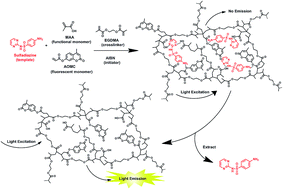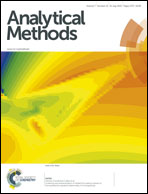Direct fluorescence quantification of sulfadiazine from quenching of novel functional monomer based molecularly imprinted polymers†
Abstract
Novel fluorescent, molecularly imprinted polymers (MIPs) were synthesized to detect sulfadiazine (SDz), an antibiotic used in animals that produce food for human consumption. Radical polymerization between a novel fluorescent monomer 7-acryloxy-4-methylcoumarin, ethylene glycol dimethacrylate and methacrylic acid, in the presence of SDz as a molecular template, afforded the target MIPs. The photoluminescence properties of these MIPs were studied and found to exhibit stable, enhanced fluorescence emission. The fluorescence emission of both the MIPs and non-imprinted polymers (NIPs) was quenched in the presence of SDz and similar analogues. Significantly, the MIPs were more sensitive than the NIPs for the SDz analyte, confirming that molecular imprinting imparted selectivity. The fluorescence quenching ratio of the MIPs exhibited a linear decrease with increasing concentrations of SDz in the range of 1.0–40 μmol L−1 with a detection limit of 0.48 μmol L−1. Importantly, the MIPs proved successful in determining SDz concentrations in spiked milk samples and showed superior recovery from 85.73% to 101.37%.


 Please wait while we load your content...
Please wait while we load your content...